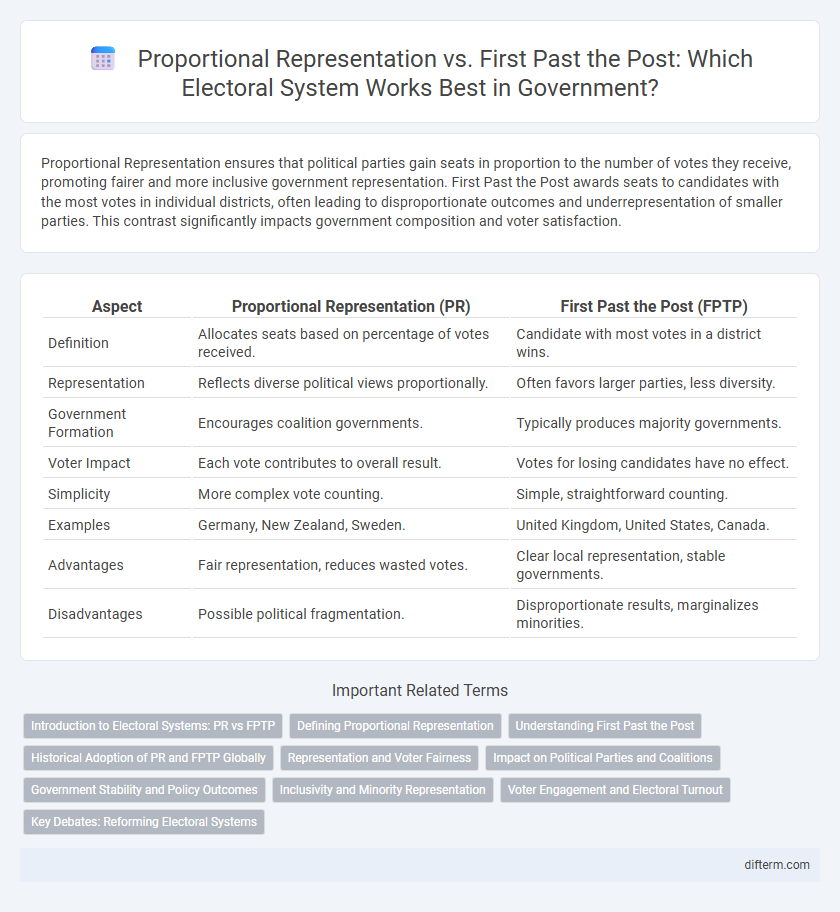Proportional Representation ensures that political parties gain seats in proportion to the number of votes they receive, promoting fairer and more inclusive government representation. First Past the Post awards seats to candidates with the most votes in individual districts, often leading to disproportionate outcomes and underrepresentation of smaller parties. This contrast significantly impacts government composition and voter satisfaction.
Table of Comparison
| Aspect | Proportional Representation (PR) | First Past the Post (FPTP) |
|---|---|---|
| Definition | Allocates seats based on percentage of votes received. | Candidate with most votes in a district wins. |
| Representation | Reflects diverse political views proportionally. | Often favors larger parties, less diversity. |
| Government Formation | Encourages coalition governments. | Typically produces majority governments. |
| Voter Impact | Each vote contributes to overall result. | Votes for losing candidates have no effect. |
| Simplicity | More complex vote counting. | Simple, straightforward counting. |
| Examples | Germany, New Zealand, Sweden. | United Kingdom, United States, Canada. |
| Advantages | Fair representation, reduces wasted votes. | Clear local representation, stable governments. |
| Disadvantages | Possible political fragmentation. | Disproportionate results, marginalizes minorities. |
Introduction to Electoral Systems: PR vs FPTP
Proportional Representation (PR) allocates seats in parliament based on the percentage of votes each party receives, promoting a more accurate reflection of the electorate's preferences. First Past the Post (FPTP) awards victory to the candidate with the most votes in a single-member district, often leading to majority governments and simpler outcomes. These contrasting electoral systems shape political landscapes by influencing party representation, voter engagement, and governance stability.
Defining Proportional Representation
Proportional Representation (PR) is an electoral system designed to allocate seats in legislatures in direct proportion to the number of votes each party receives, ensuring a more accurate reflection of the electorate's preferences. Unlike First Past the Post (FPTP), which awards seats to the candidate with the most votes in single-member districts, PR aims to minimize wasted votes and increase minority party representation. Systems like party-list PR and mixed-member proportional representation are common mechanisms that enhance political diversity and fairness in government formation.
Understanding First Past the Post
First Past the Post (FPTP) is a voting system where the candidate with the most votes in a single-member constituency wins, regardless of whether they achieve an absolute majority. This plurality method simplifies vote counting but often leads to disproportionate representation, favoring larger parties and marginalizing smaller ones. FPTP tends to produce stable majority governments but can distort voter preferences and reduce overall electoral fairness compared to Proportional Representation systems.
Historical Adoption of PR and FPTP Globally
Proportional Representation (PR) was first widely adopted in the early 20th century, influencing countries like Sweden in 1909 and Germany during the Weimar Republic era, promoting multiparty systems and diverse political representation. First Past the Post (FPTP) remains dominant in former British colonies such as the United Kingdom, Canada, and India, favoring majoritarian governance and simpler electoral mechanisms since the 19th century. Globally, PR systems have gained traction in European and Latin American democracies seeking fairer vote-to-seat ratios, while FPTP persists in anglophone nations emphasizing political stability and clear electoral outcomes.
Representation and Voter Fairness
Proportional Representation ensures a more accurate reflection of voter preferences by allocating seats based on the percentage of votes each party receives, promoting fairer representation for minority groups. First Past the Post often results in disproportionate outcomes where majority parties gain an outsized share of seats, marginalizing smaller parties and voters. This system can lead to voter disenfranchisement as individuals supporting losing candidates find their votes have little impact on overall representation.
Impact on Political Parties and Coalitions
Proportional Representation (PR) encourages multiparty systems by allocating seats based on vote share, enabling smaller parties to gain representation and fostering coalition governments. First Past the Post (FPTP) tends to favor larger parties, often resulting in majority governments and reducing the influence of minor parties. The electoral system impacts political party strategies, coalition formation, and overall party system fragmentation.
Government Stability and Policy Outcomes
Proportional Representation tends to produce coalition governments that encourage broader representation but can lead to policy gridlock and unstable alliances. First Past the Post systems often yield majority governments, providing greater policy continuity and decisiveness, but risk marginalizing minority views. The choice between these systems significantly impacts government stability and the inclusiveness of policy outcomes.
Inclusivity and Minority Representation
Proportional Representation (PR) enhances inclusivity by allocating seats based on the percentage of votes each party receives, ensuring minority groups gain fair representation in the legislature. First Past the Post (FPTP) often marginalizes smaller parties and minority voices, as candidates with the most votes win regardless of overall vote distribution. Comparative studies show PR systems lead to more diverse parliaments and greater political participation among underrepresented communities.
Voter Engagement and Electoral Turnout
Proportional Representation (PR) systems tend to increase voter engagement and electoral turnout by ensuring that votes contribute directly to the allocation of seats, motivating broader participation. In contrast, First Past the Post (FPTP) often results in voter apathy due to wasted votes in non-competitive districts, leading to lower turnout. Studies show countries with PR experience consistently higher turnout rates averaging around 75%, compared to roughly 65% in those using FPTP.
Key Debates: Reforming Electoral Systems
Proportional Representation (PR) ensures that parties gain seats in proportion to their share of the vote, promoting inclusivity and reflected voter preferences, whereas First Past the Post (FPTP) often results in disproportionate majorities and marginalizes smaller parties. Key debates center on balancing representational fairness with stable governance, as PR tends to produce coalition governments while FPTP supports clearer majorities. Reform advocates emphasize increasing voter equity and reducing wasted votes, while opponents argue that PR can lead to fragmented legislatures and policy gridlock.
Proportional Representation vs First Past the Post Infographic

 difterm.com
difterm.com